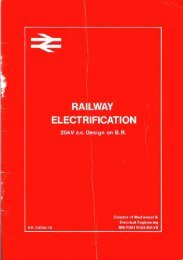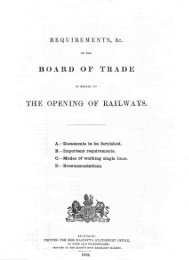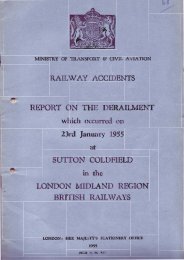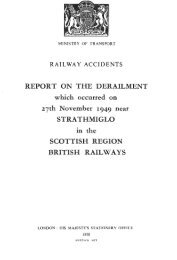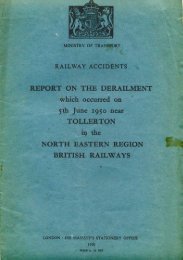R A I LT R AC K - The Railways Archive
R A I LT R AC K - The Railways Archive
R A I LT R AC K - The Railways Archive
Create successful ePaper yourself
Turn your PDF publications into a flip-book with our unique Google optimized e-Paper software.
Route characteristics<br />
DESCRIPTION <strong>The</strong>se routes are primarily two tracks but with a considerable<br />
mileage of single track, mainly Perth–Inverness and Aberdeen–Inverness. Four<br />
tracks are available between Edinburgh Waverley and Haymarket West Junction.<br />
<strong>The</strong> signalling is a mixture of semaphore and colour light. A short section of the<br />
route is electrified using 25kV OLE.<br />
Maximum speeds range from 50mph between Winchburgh and Dalmeny<br />
to 100mph over parts of the Edinburgh–Glasgow route. Differential speeds for<br />
multiple unit trains over locomotive-hauled stock are available between Edinburgh<br />
and Aberdeen.<br />
<strong>The</strong> Haymarket–Edinburgh Waverley area is operating at a high level of<br />
utilisation. Other busy sections near to capacity are Glasgow–Greenhill Junction,<br />
Aberdeen–Dyce, and parts of Fife.<br />
Route vision<br />
<strong>The</strong> ‘Express Route’ acts as the ra i lw ay art e ry of Scotland connecting the main<br />
centres of population and the principal cities of Edinbu rgh, Glasgow, Pe rth, Dundee,<br />
Aberdeen and Inve rness. Our vision is to develop the route as the principal mode<br />
of tra n s p o rt between the main centres of gove rnment, commerce, industry and<br />
culture that will serve the people of Scotland into the next millennium, prov i d i n g<br />
more train paths and faster journeys with greater comfo rt and reliability.<br />
We have undertaken a study on behalf of the industry to establish future<br />
growth in rail travel. Analysis suggests that, between 1996 and 2008, the number<br />
of passenger journeys will grow by between 25% and 30%, the main growth<br />
being in the leisure mar ket followed by commuting and business.<br />
We will deliver this vision through the ability to increase the frequency and<br />
reduce journey times without significantly altering the infrastructure, through<br />
extensive works such as electrification, additional track capacity or major<br />
resignalling. Reduced journey time is a key market requirement. <strong>The</strong><br />
improvements will be provided by judiciously combining condition-led renewals<br />
Route development and customer requirements<br />
ScotRail This year, ScotRail are doubling the train frequency to every 15<br />
minutes between Edinburgh and Glasgow with the journey time reduced by two<br />
minutes. This is to be followed by additional services over other sections of the<br />
route. <strong>The</strong>se requirements are being met by us through providing appropriate<br />
train paths and ensuring that the infrastructure is reliable through an enhanced<br />
maintenance regime over key sections of the route. <strong>The</strong>y also require reduced<br />
journey times particularly between Edinburgh and Aberdeen, Edinburgh, Glasgow<br />
and Inverness, as well as Aberdeen and Inverness. As a first stage, we are<br />
working to reduce the journey time between Edinburgh and Aberdeen by ten<br />
minutes and Aberdeen and Inverness by up to ten minutes.<br />
As part of their ScotRail 2000 project, they require improved customerinformation<br />
systems, enhanced station security and extensions to selected station<br />
car parks. We have commenced works to meet these requirements. <strong>The</strong> new<br />
trains being introduced between Edinburgh–Glasgow and Aberdeen–Edinburgh<br />
require improved facilities to enable them to operate successfully. <strong>The</strong>y need to<br />
be able to discharge train toilets, as well as to extend the trainshed at Haymarket<br />
Depot. <strong>The</strong> designs for these facilities are well advanced. Improved infrastructure<br />
performance and minimal interruption due to engineering work are essential to<br />
support these increases in services.<br />
GNER and Virgin CrossCountr y are primarily interested in reduced journey<br />
times from Inverness and Aberdeen to Edinburgh for their through trains<br />
MAJOR STATIONS We have continued to invest in a number of short-term<br />
projects aimed at improving facilities at the Edinburgh Waverley Station. It has<br />
been made more environmentally friendly by the segregation of pedestrians from<br />
road vehicles, at the same time improving retail outlets. <strong>The</strong> passenger waiting<br />
area has been restored, including the cupola, which received a special mention in<br />
the Ian Allan Heritage Awards.<br />
Our predictions for growth of train services at Edinburgh indicate that<br />
significant alterations will be required to the track and signalling throughout the<br />
station area to provide more and increased flexibility to platforms. This can only<br />
be accomplished by major alterations to its fabric. We propose to redevelop the<br />
station while preserving its historic character to provide Edinburgh with a<br />
modern structure befitting a capital city. We are working with all interested<br />
parties to achieve this goal.<br />
with enhancements where there are commercial benefits. In October 1999<br />
ScotRail will increase the train frequency between Glasgow and Edinburgh to<br />
every 15 minutes. Journey times between Edinburgh and Glasgow to Aberdeen<br />
and Inverness will be progressively reduced through a combination of track work<br />
and the utilisation of new curving rules. This is being achieved as a result of our<br />
initiative which is being taken forward with the European Union of <strong>Railways</strong> and<br />
is expected to be of benefit to many railway authorities. Our longer-term vision is<br />
to achieve a two-hour journey time using tilting trains between Edinburgh and<br />
Aberdeen.<br />
We anticipate the continued expansion of freight traffic with the provision<br />
of new sidings. <strong>The</strong>se will provide an increased ability to carry larger, longer and<br />
heavier trains, linking the north of Britain to the south and Europe via the<br />
Channel Tunnel. <strong>The</strong>se measures will enable more freight to be transferred from<br />
busy roads such as the A9 and A90 to rail, benefiting the environment, allowing<br />
goods to move without congestion and helping to reduce road accidents.<br />
to London and southern Britain. An initial reduction of ten minutes between<br />
Aberdeen and Edinburgh could be followed by a two-hour journey time by<br />
utilising tilting trains. <strong>The</strong>y also want improvements in reliability as well as<br />
maintenance of the high standard of track quality historically enjoyed in Scotland.<br />
This is being provided by enhanced maintenance at selected locations.<br />
EWS requires improved access to operate larger, heavier and longer trains. In<br />
particular, they want to ensure that sidings for loading and unloading are available<br />
where and when requested by their customers. We are currently identifying a<br />
suitable scheme between Arbroath and Montrose.<br />
Local authorities <strong>The</strong> key priority is to improve the accessibility of railways<br />
and station facilities. Examples include:<br />
• new stations throughout<br />
• local trains between Inverurie and Stonehaven providing a cross-Aberdeen<br />
service<br />
• a reduction in journey time between Aberdeen and Inverness<br />
• reduced journey times and increases in services between Fife and Edinburgh<br />
• reopening of the Stirling–Alloa through to Kincardine for freight and eventually<br />
passenger services<br />
• involvement in a new integrated transport interchange facilities at Perth and<br />
Inverkeithing.<br />
211



